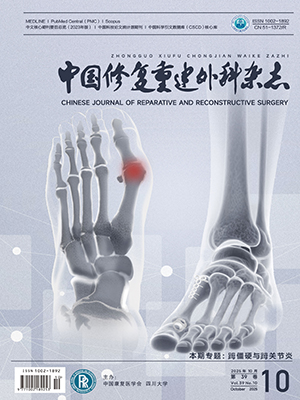| 1. |
El-Sobky TA, Samir S, Baraka MM, et al. Growth modulation for knee coronal plane deformities in children with nutritional rickets: a prospective series with treatment algorithm. J Am Acad Orthop Surg Glob Res Rev, 2020, 4(1): e19.00009. doi: 10.5435/JAAOSGlobal-D-19-00009.
|
| 2. |
Linglart A, Biosse-Duplan M, Briot K, et al. Therapeutic management of hypophosphatemic rickets from infancy to adulthood. Endocr Connect, 2014, 3(1): R13-R30.
|
| 3. |
Sako S, Niida Y, Shima KR, et al. A novel PHEX mutation associated with vitamin D-resistant rickets. Hum Genome Var, 2019, 6: 9. doi: 10.1038/s41439-019-0040-3.
|
| 4. |
Beck-Nielsen SS, Mughal Z, Haffner D, et al. FGF23 and its role in X-linked hypophosphatemia-related morbidity. Orphanet J Rare Dis, 2019, 14(1): 58. doi: 10.1186/s13023-019-1014-8.
|
| 5. |
Al Kaissi A, Farr S, Ganger R, et al. Windswept lower limb deformities in patients with hypophosphataemic rickets. Swiss Med Wkly, 2013, 143: w13904. doi: 10.4414/smw.2013.13904.
|
| 6. |
Suparatchatadej C, Adulkasem N, Ariyawatkul T, et al. Predictive factors for recurrence after lower limb deformity correction in hypophosphatemic rickets. J Orthop Surg Res, 2023, 18(1): 488. doi: 10.1186/s13018-023-03963-7.
|
| 7. |
Paludan CG, Thomsen KKV, Rahbek O, et al. Complications of orthopedic treatment in patients diagnosed with X-linked hypophosphatemic rickets. J Pediatr Endocrinol Metab, 2022, 35(8): 1003-1009.
|
| 8. |
Scorcelletti M, Kara S, Zange J, et al. Lower limb bone geometry in adult individuals with X-linked hypophosphatemia: an observational study. Osteoporos Int, 2022, 33(7): 1601-1611.
|
| 9. |
Francis HG , Lynda FB, Nicholas CH, et al. Potential influences on optimizing long-term musculoskeletal health in children and adolescents with X-linked hypophosphatemia (XLH). Orphanet J Rare Dis, 2022, 17(1): 30. doi: 10.1186/s13023-021-02156-x.
|
| 10. |
王钞崎, 秦泗河, 王栋, 等. 低磷性佝偻病肢体畸形的研究进展. 中国矫形外科杂志, 2023, 31(23): 2148-2153.
|
| 11. |
杜辉, 李恒, 李兴, 等. 成人低磷性佝偻病的手术治疗策略探讨. 中华骨与关节外科杂志, 2024, 17(6): 516-524.
|
| 12. |
Bueno-Sánchez AM. Surgical indications in hypophosphataemic rickets. Adv Ther, 2020, 37(Suppl 2): 113-120.
|
| 13. |
Rocco FD, Rothenbuhler A, Adamsbaum C, et al. Orthopedic and neurosurgical care of X-linked hypophosphatemia. Arch Pediatr, 2021, 28(7): 599-605.
|
| 14. |
Sharkey MS, Grunseich K, Carpenter TO. Contemporary medical and surgical management of X-linked hypophosphatemic rickets. J Am Acad Orthop Surg, 2015, 23(7): 433-442.
|
| 15. |
陈坚, 邢丹, 臧建成. 矫形外科原则. 北京: 北京大学医学出版社, 2023: 61-99.
|
| 16. |
Li J, Rai S, Ze R, et al. Rotational and translational osteotomy for treatment of severe deformity in hypophosphatemic rickets: A case report. Medicine (Baltimore). 2020, 99(3): e18425. doi: 10.1097/MD.0000000000018425.
|
| 17. |
Oba M, Choe H, Yamada S, et al. Corrective osteotomy for complex tibial deformity in a patient with hereditary vitamin D-resistant hypophosphatemic rickets (HVDRR) using CT-based navigation system and 3D printed osteotomy model. Comput Assist Surg (Abingdon), 2022, 27(1): 84-90.
|
| 18. |
Gizard A, Rothenbuhler A, Pejin Z, et al. Outcomes of orthopedic surgery in a cohort of 49 patients with X-linked hypophosphatemic rickets (XLHR). Endocr Connect, 2017, 6(8): 566-573.
|
| 19. |
Eralp L, Kocaoglu M, Toker B, et al. Comparison of fixator-assisted nailing versus circular external fixator for bone realignment of lower limb angular deformities in rickets disease. Arch Orthop Trauma Surg, 2011, 131(5): 581-589.
|
| 20. |
Popkov A, Aranovich A, Popkov D. Results of deformity correction in children with X-linked hereditary hypophosphatemic rickets by external fixation or combined technique. Int Orthop, 2015, 39(12): 2423-2431.
|
| 21. |
Song HR, Soma Raju VV, Kumar S, et al. Deformity correction by external fixation and/or intramedullary nailing in hypophosphatemic rickets. Acta Orthop, 2006, 77(2): 307-314.
|
| 22. |
Wirth T. The orthopaedic management of long bone deformities in genetically and acquired generalized bone weakening conditions. J Child Orthop, 2019, 13(1): 12-21.
|
| 23. |
Mindler GT, Kranzl A, Stauffer A, et al. Lower limb deformity and gait deviations among adolescents and adults with X-linked hypophosphatemia. Front Endocrinol (Lausanne), 2021, 12: 754084. doi: 10.3389/fendo.2021.754084.
|
| 24. |
Koren L, Keren Y, Eidelman M. Multiplanar deformities correction using Taylor spatial frame in skeletally immature patients. Open Orthop J, 2016, 6(10): 71-79.
|
| 25. |
焦绍锋, 秦泗河, 王振军, 等. 有限内固定结合骨外固定器治疗股骨下段畸形. 中国骨伤, 2011, 24(8): 695-697.
|
| 26. |
焦绍锋, 秦泗河, 王振军, 等. 单套Taylor外固定架联合双平面截骨矫正胫骨多平面畸形. 中国修复重建外科杂志, 2023, 37(7): 839-845.
|
| 27. |
张伟业, 万春友, 张涛, 等. Taylor空间外固定架在膝内侧间室骨关节炎下肢力线调整中的临床应用. 中国修复重建外科杂志, 2020, 34(4): 452-456.
|




